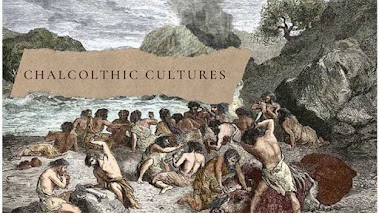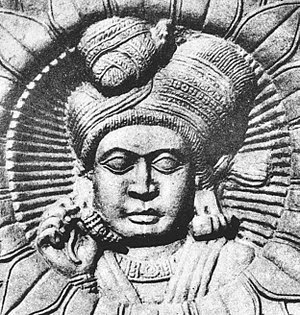The Chalcolithic Age : When Metallurgy Came to Rule the World
The chalcolithic period refers to that part of old-world prehistory wedged between Neolithic, and the urban and literate societies of bronze age. This was the era when the first metal was found and it was nothing else but the copper and there was extensive use of mixture of stone and copper as stone increases strength it had been added to copper. The term Chalcolithic is a combination of two words- Chalco + Lithic was derived from the Greek words "khalkos" + "líthos" which means "copper" and "stone" or Copper Age. It is also known as the Eneolithic or Aneolithic (from Latin aeneus "of copper") is an archaeological period that is usually considered to be part of the broader Neolithic (although it was originally defined as a transition between the Neolithic and the Bronze Age). Copper age is associated with wide-spread Copper Metallurgy.
Credits: https://www.alchemyias.com/
In India, it spanned around 2000 BC to 700 BC. This culture was mainly seen in pre Harappan phase, but at many places it extended to post-Harappan phase too. The people were mostly rural and lived near hills and rivers. The largest site of the Chalcolithic period is Diamabad situated on the left bank of the Pravara River. Major sites of Malwa Culture include Daimabad, Inamgaon, Kayatha, Nagda, Vidisha, Eran, Mandsaur, and Navdatoli.
Characteristics of Chalcolithic Age
1.Pottery:
A main identifying characteristic of the Chalcolithic period is polychrome painted pottery. Ceramic forms found on Chalcolithic sites include "fenestrated pottery", pots with openings cut into the walls, which may have been used for burning incense, as well as large storage jars and serving jars with spouts. Stone tools include adzes, chisels, picks and chipped stone tools with central perforations. In this age, Potteries of mostly red and black color containing white lining had been prevalent. Madhya Pradesh and Maharashtra produced channel spouted pots dishes on stand and bowls on stand.
Credits:PAINTED POTTERY FROM SHIKMIM, CHALCOLITHIC PERIOD - 3RD. MILLENNIUM Stock Photo - Alamy
Credits: The Chalcolithic ot Eneolithic or Aeneolithic or Copper Age (jagranjosh.com)
People living in south-eastern Rajasthan, western Madhya Pradesh and western Maharashtra domesticated animals such as cows, sheep, goat, pigs, buffaloes, deer etc. Remains of camels are also found. People certainly ate beef. People started producing wheat, rice, staple crop-bajra, pulses-masoor, gram pea, green gram. Almost all these food grains have been found at Navdatoli situated on the bank of Narmada in Maharashtra. People of Navdatoli also produced Linseed and Ber. Cotton was produced in black cotton soil of Deccan and Ragi, Bajra and several millets cultivated in a lower deccan.
2. Houses :
The Chalcolithic people were generally not acquainted with burnt bricks which were seldom used which also shows that these people had not learnt the art of burnt brick method from Indus people. Houses were made of mud bricks, but mostly those were constructed with wattle and daub and seem to have been thatched houses. At Inamgaon sites, mud houses with circular pit had been discovered. In later phase (1300-1000 B.C) people generally had houses with 5 rooms, four rectangular and one circular, indicating that families were large. Settlements became stable and widespread in this phase, thus called Jorwe culture. This is so called, because the type-site found is Jorwe which is situated on the Pravara river. These people were also had well plasters with the help of cow dung and lime. Line can be obtained from natural vegetation at that time.
3.Art and
Culture:
People of
this age knew the art of spinning and weaving because spindle whorls have been
discovered in Malwa. They were well acquainted in cloth making. Cotton, silk
threads and flax have been in Maharashtra.
Spindle Whorl
4.Burials:
In Maharashtra, people buried their dead in urns under the floor of their house in the north-south direction. They did not use special cemeteries for this purpose like Harappan people. Pots and some copper objects were found in the graves near dead signifying the myth of their use in next world. Terracotta figure of women found which shows that these people worship mother goddess. In Malwa and Rajasthan stylized bull terracottas show that bull served as religious cult.
In this stone-copper age, we find the beginning of social inequalities. In the graves at Chandoli and Nevasa in western Maharashtra some children were buried along with the copper-bead necklaces around their necks; other children had grave goods consisting only of pots. In Kayatha, dead were found buried along with 29 copper bangles and two unique axes. At the same place were found earthen pots necklaces of semi-precious stones such as steatite and carnelian beads showing that the people possessing these objects were affluent.
Importance of Chalcolithic age
Chalcolithic area is spread all over throughout the country except for alluvial region and thick forests. These people had settlements on river banks and they used Microlithic tools of stone and copper. Also because of discovery of copper, these people also knew the art of smelting .These people were using mostly black and red color, wheeled turned pots ,these pots were used for cooking, storing, eating and drinking. Extensive use of lots and thali is seen.
At some places, there is seen the affect of Neolithic. Some things are as it is copied from there in Chalcolithic. So, this phase was referred as Neolithic- Chalcolithic. People of this age gray barley, lentils and rice. Fish and rice were important food. In Maharashtra, the dead were buried in north-south direction while in south India in the east west direction.
Limitations of Chalcolithic age
People of this age do not have knowledge of alloying of metals so they were unable to use the stronger metal such as bronze nicely. Despite of high food producing economy, rate of infant mortality was high. Supply of copper was limited. People were not aware about art of writing in spite of being followers of Indus people. They did not gain any benefit of technical knowledge from Indus people.
Blog Credits : Anjali Nawkar(Team Historic
Wednesday)
Other References :
https://www.jagranjosh.com/general-knowledge/the-chalcolithic-culture-1430564033-1
https://www.thoughtco.com/chalcolithic-period-copper-mettalurgy-170474
NOTE :-
This blog is meant for Educational Purpose only .We do not own any Copyrights related to images and information , all the rights goes to their respective owners . The soul purpose of this blog is to Educate, Inspire, Empower and to create awareness in the viewers. The usage is non-commercial(Not For Profit) and we do not make any money from it.






Comments
Post a Comment